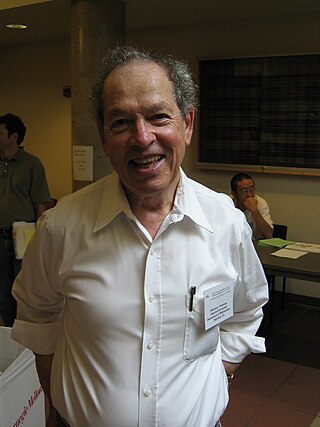
Solomon Feferman was an American philosopher and mathematician who worked in mathematical logic. In addition to his prolific technical work in proof theory, computability theory, and set theory, he was known for his contributions to the history of logic and as a vocal proponent of the philosophy of mathematics known as predicativism, notably from an anti-platonist stance.
The spectrum of a linear operator that operates on a Banach space is a fundamental concept of functional analysis. The spectrum consists of all scalars such that the operator does not have a bounded inverse on . The spectrum has a standard decomposition into three parts:

Neil Immerman is an American theoretical computer scientist, a professor of computer science at the University of Massachusetts Amherst. He is one of the key developers of descriptive complexity, an approach he is currently applying to research in model checking, database theory, and computational complexity theory.
William S. Hatcher (1935–2005) was an American mathematician, philosopher, educator and a member of the Baháʼí Faith. He held a doctorate in mathematics from the University of Neuchatel, Switzerland, and bachelor's and master's degrees from Vanderbilt University in Nashville, Tennessee. A specialist in the philosophical alloying of science and religion, for over thirty years he held university positions in North America, Europe, and Russia.
In the mathematical discipline of functional analysis, the concept of a compact operator on Hilbert space is an extension of the concept of a matrix acting on a finite-dimensional vector space; in Hilbert space, compact operators are precisely the closure of finite-rank operators in the topology induced by the operator norm. As such, results from matrix theory can sometimes be extended to compact operators using similar arguments. By contrast, the study of general operators on infinite-dimensional spaces often requires a genuinely different approach.
In mathematical analysis, the Hilbert–Schmidt theorem, also known as the eigenfunction expansion theorem, is a fundamental result concerning compact, self-adjoint operators on Hilbert spaces. In the theory of partial differential equations, it is very useful in solving elliptic boundary value problems.

In mathematics, Hilbert spaces allow the methods of linear algebra and calculus to be generalized from (finite-dimensional) Euclidean vector spaces to spaces that may be infinite-dimensional. Hilbert spaces arise naturally and frequently in mathematics and physics, typically as function spaces. Formally, a Hilbert space is a vector space equipped with an inner product that induces a distance function for which the space is a complete metric space. A Hilbert space is a special case of a Banach space.
Barbara Diane MacCluer is an American mathematician. She is a former professor of mathematics at the University of Virginia and now a professor emeritus there. Her research specialty is in operator theory and composition operators. She is known for the books she has written on this subject and related areas of functional analysis.
Jean Estelle Hirsh Rubin was an American mathematician known for her research on the axiom of choice. She worked for many years as a professor of mathematics at Purdue University. Rubin wrote five books: three on the axiom of choice, and two more on more general topics in set theory and mathematical logic.

Fioralba Cakoni is an American-Albanian mathematician and an expert on inverse scattering theory. She is a professor of mathematics at Rutgers University.
Martin Grohe is a German mathematician and computer scientist known for his research on parameterized complexity, mathematical logic, finite model theory, the logic of graphs, database theory, descriptive complexity theory, and graph neural networks. He is a University Professor of Computer Science at RWTH Aachen University, where he holds the Chair for Logic and Theory of Discrete Systems.
Marian Boykan Pour-El was an American mathematical logician who did pioneering work in computable analysis.
Nail Hairullovich Ibragimov was a Russian mathematician and mathematical physicist. At his death he was a professor emeritus at the Blekinge Institute of Technology. Ibragimov's research area was differential calculus, group analysis and mathematical physics. He was the author of many books on mathematics and mathematical physics.
Anita Burdman Feferman was an American historian of mathematics and biographer, known for her biographies of Jean van Heijenoort and of Alfred Tarski.
Clàudia Valls Anglés is a mathematician and an expert in dynamical systems. She is an associate professor in the Instituto Superior Técnico of the University of Lisbon in Portugal.

Christiane Tretter is a German mathematician and mathematical physicist who works as a professor in the Mathematical Institute (MAI) of the University of Bern in Switzerland, and as managing director of the institute. Her research interests include differential operators and spectral theory.
Joan Livingston Richards is an American historian of mathematics and a professor of history at Brown University, where she directs the Program of Science and Technology Studies.
Patricia A. Blanchette is an American philosopher and logician, the McMahon-Hank Professor of Philosophy at the University of Notre Dame. She specializes in the history of philosophy, history of logic, philosophy of logic, philosophy of mathematics, and philosophy of science, and is the author of a book on the logic of Gottlob Frege.
Deborah Jo Bennett is an American mathematician, mathematics education scholar, and book author. She is a professor of mathematics at New Jersey City University.
Jane Elizabeth Kister was a British and American mathematical logician and mathematics editor who served for many years as an editor of Mathematical Reviews.





